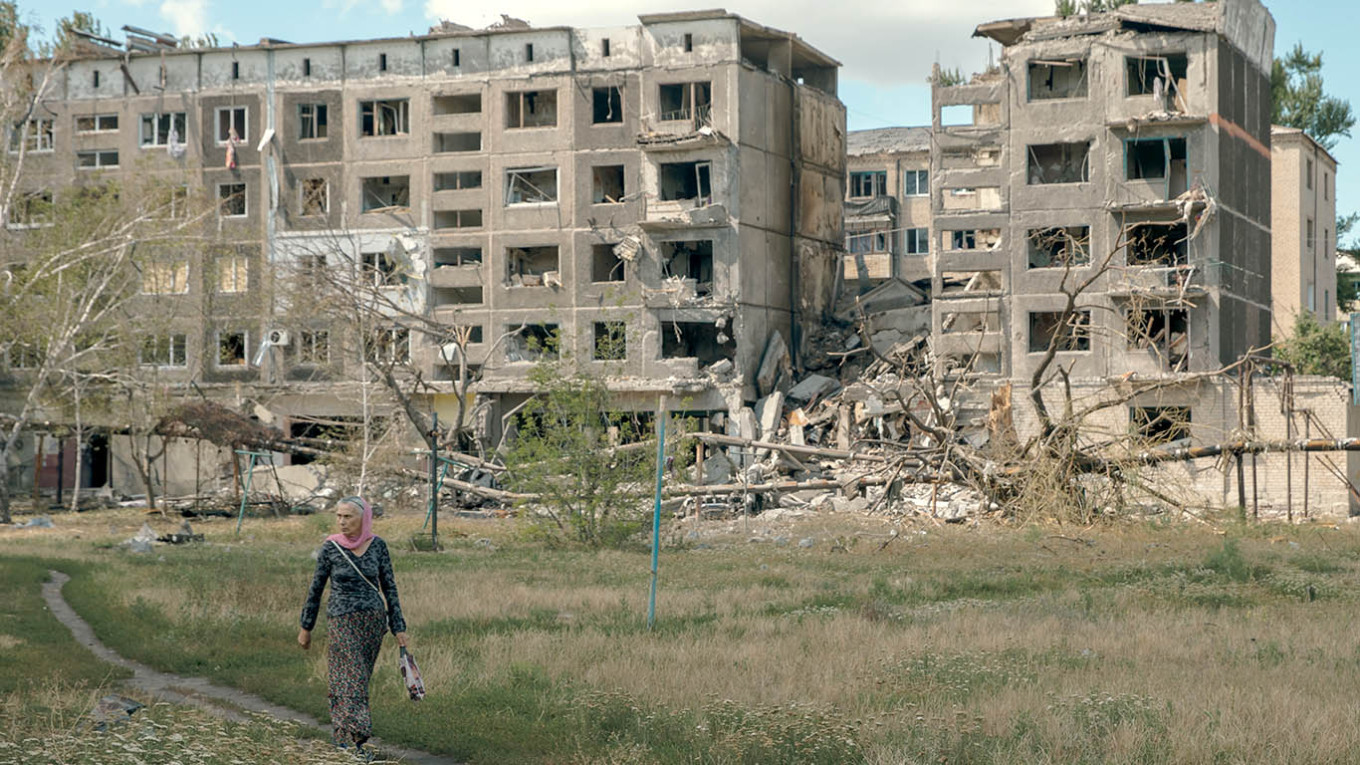DONETSK REGION, Ukraine — On the salty banks of Sloviansk, Sasha, a 22-year-old soldier from Kherson, enjoys a beer while smoking a cigarette. The salt lakes behind him sparkle, creating an illusion where sky and land blend seamlessly. In the distance, a plume of smoke signifies something ablaze. Along the water’s edge, civilians and returning refugees, who have come back for a brief weekend in their homeland, sit uneasily alongside soldiers on rotation.
The summer feels never-ending, stretching longer than any winter. Faces are weary, lacking expression.
Located just 22 kilometers (13.6 miles) from the front, the Sloviansk lake area is one of the few remaining delicate havens of tranquility in the Donetsk region. Since late spring, Russian forces have intensified their efforts along the front lines and are now attempting to encircle the city of Kostiantynivka.
“Pokrovsk might fall by autumn,” a soldier informs me.
On the diplomatic side, Ukraine is navigating a transformation in its relationship with the U.S. during the Trump administration. Kyiv has opted for a conciliatory approach, agreeing to terms like an unconditional 30-day ceasefire and a deal over rare-earth minerals negotiated with Washington.
Initially, this strategy seemed fruitful. Amid diplomatic efforts led by Ukraine’s European allies and the ongoing Russian bombardments of Ukrainian cities, Trump’s rhetoric appeared to toughen, considering new sanctions against Moscow.
However, at an August 15 summit in Alaska, President Vladimir Putin dangled the possibility of peace in Ukraine before Trump, suggesting he could reduce his ambitions. In return for ceasing hostilities along the southern front, Moscow insisted on the full withdrawal of Ukrainian forces from the Donetsk region, approximately 70% of which is under Russian control.
Ukrainian President Volodymyr Zelensky rejected this proposition, emphasizing that Ukraine’s constitution prohibits territorial concessions.
Moreover, it is almost inconceivable for Ukraine to relinquish its remaining land in Donetsk, one of the country’s most fortified regions, which serves as a buffer against Russian advances toward Kharkiv and Dnipro, according to Kyiv-based foreign policy and security analyst Jimmy Rushton.
“Ukraine has established the Donbas line, a series of fortifications across Donetsk,” Rushton stated. “It is well-engineered, with deep anti-tank ditches, trench systems, and reinforced concrete installations. Many of them were constructed at significant expense.”
Abandoning these defenses would leave Ukraine vulnerable, he warned.
“The terrain behind is flat and unprotected, lacking prepared defenses,” he remarked. “Donetsk offers elevated terrain and established strongholds, making it much easier to defend.”
While far removed from the diplomatic discussions, Sasha has directly experienced the war.
“I spent three years in the infantry. I’m one of the few survivors from my initial unit,” he recounts quietly. “Now, I serve in artillery. My body can’t handle the infantry anymore.”
He doesn’t think beyond the immediate future. For him, the notion of peace, whether promised by Washington or Moscow, seems implausible.
“It will take them years to conquer all of Donbas,” he states. “So why surrender it for nothing? How can we let it go after so many of our friends and family have lost their lives on the front lines?”
Nonetheless, Sasha is aware of Russia’s formidable capabilities. The Donbas front has always posed challenges. He recognizes that Ukraine cannot reclaim lost territories.
“It’s better to halt them at the contact line. We need to reinforce, create a drone barrier, and make any advance impossible,” he suggests.
However, he also acknowledges the enormity of the task. Unlike Russia, which enjoys a demographic advantage, Ukraine faces challenges in recruitment — a manpower shortage that significantly weakens Kyiv’s defenses.
Just before the Trump-Putin summit, Russian forces advanced by 17 kilometers on the eastern front near Dobropillia, a town close to Pokrovsk.
According to DeepState Map, an independent platform monitoring the frontline, the breach was quickly contained, with the Azov and Da Vinci brigades splitting the salient and driving out Russian sabotage units known as DRG.
Although this operation also served as a Russian public relations move prior to the Alaska summit, it highlighted vulnerabilities in Ukraine’s defenses.
Bohdan Krotevych, chief of staff of the Azov Brigade, indicated that the issue extends beyond fortifications.
In candid Telegram posts, he suggested that while Ukraine has built sufficient defenses, it lacks the manpower to maintain them.
“In defense without fortifications, in assault without reserves,” he wrote. “Officers no longer lead soldiers; they drag in whoever is left standing.”
Describing the porous state of the frontline, Krotevych noted that exhausted and understrength units are compelled to hold extensive areas with minimal personnel.
“Across a sector of more than five kilometers, we have about 10, at most 12 fighters. The defense is maintained by drivers, artillery personnel, and cooks. But even they are worn out. In the battalions, only 25% of the manpower remains, most of whom have been wounded before and are now serving as drivers or orderlies just to remain useful.”
He added that the issue is exacerbated by the lack of genuine reinforcements.
“When another battalion is depleted, we do not receive newcomers; we only see a redistribution. People do not come in; they are spread thin across countless gaps,” he explained.
After the Russian advance near Dobropillia, Sasha remained succinct.
“They keep launching assaults. But we hold them back. They’re advancing inch by inch. We still lack everything, though. But do we have any real choice?” he asks. “After Donetsk, they will continue advancing. It’s better that they pay the cost here, where we have solid fortifications.”
French defense consultant Xavier Tytelman argues that while the breach constituted a Ukrainian error, it also revealed Russia’s inability to capitalize on breakthroughs.
“The assaults have become increasingly ineffective,” he says. “The Russians still have soldiers willing to sacrifice themselves to place a flag. But they lack the vehicles. Even when they find a gap, they don’t have the resources to deploy 20 tanks, engineering units to dig trenches, or demining equipment. They lack the material support to take advantage of their infantry successes. This indicates Russia no longer possesses the maneuverability it once did.”
This, he asserts, illustrates why Ukraine has little incentive to relinquish the Donetsk region in exchange for a tenuous promise of peace from Russia.
“Russia captured less than 4,000 square kilometers last year,” he points out. “At this rate, it would take them two years to fully seize the Donetsk region if they were to concentrate all their forces. But they can’t, as they are also engaged in Sumy, Kharkiv, Zaporizhzhia, and Kherson.”
Rushton concurs, highlighting that cities like Kramatorsk, Sloviansk, and Druzhkivka form a crucial defensive line.
“Since 2014, Ukraine has fortified these areas with underground structures and industrial complexes, similar to Mariupol’s Azovstal. Together with the Donbas line, they make this region uniquely defensible,” he states.
As they return from Sloviansk, the landscape shows clear signs of Russian advances. Excavators dig into fields, creating trench after trench.
Across the plain, dragon’s teeth stretch for miles, with sunflowers already sprouting between the concrete.
“The Kremlin knows we will not back down,” Sasha sighs. “What they desire is for us to bear the blame for the failure of peace. Then Putin can claim it’s Ukraine’s fault. Maybe the Americans will reduce weapon supplies or intelligence. But even that, I’m uncertain, would suffice for Russia to take the entirety of Donbas in the next two or three years. Not at this rate.”

